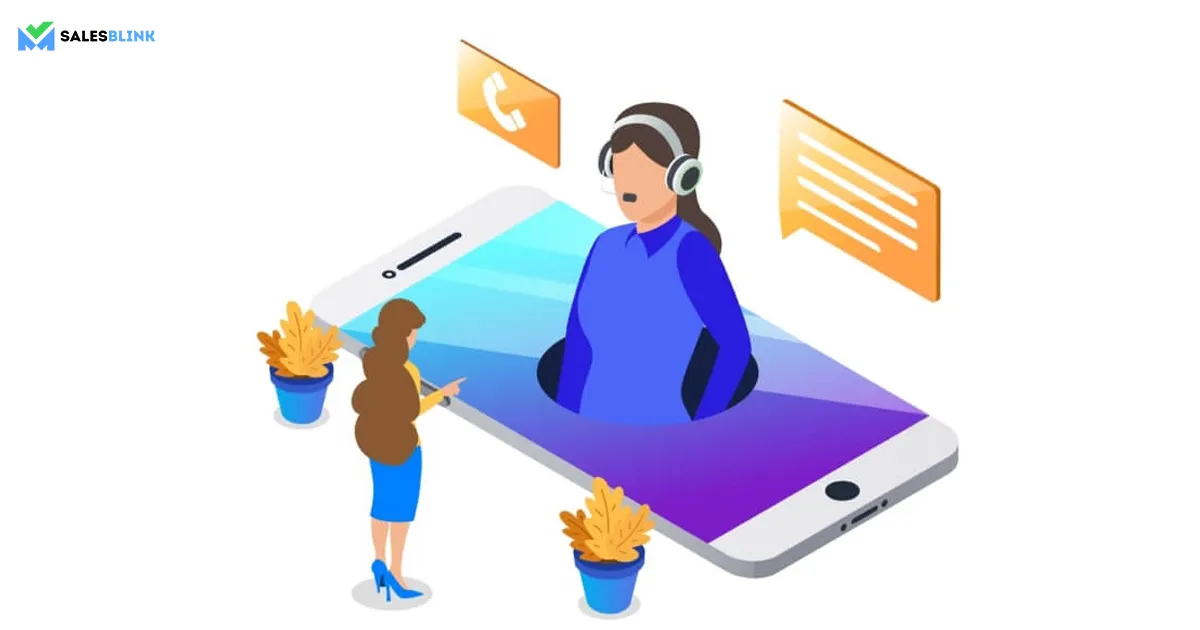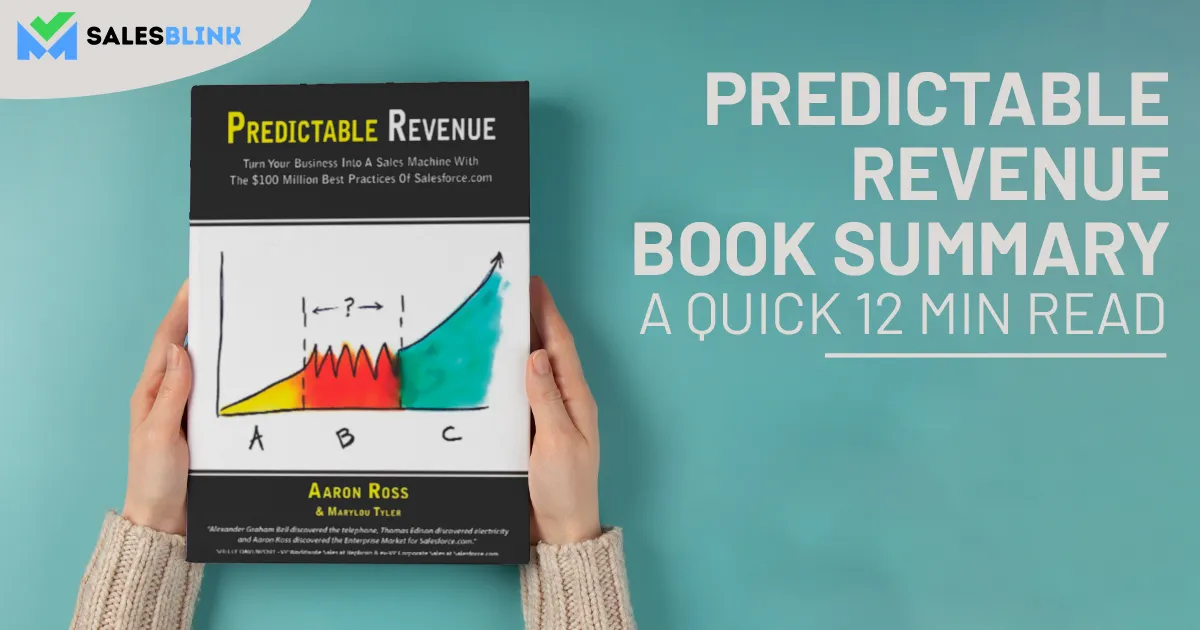Predictable Revenue Book Summary – A Quick 12 Min Read
Predictable Revenue by Aaron Ross and Marylou Tyler is a well-know book in the sales circle. Referred to as “The Sales Bible of Silicon Valley”, the book discovers the sales specialization system and outbound sales process that added $100 million to Salesforce.com’s recurring revenue and nearly doubled the growth of the enterprise.
Most entrepreneurs struggle with stability, as it is not possible to predict how much revenue a business would earn. This book presents an entirely new kind of sales system for CEOs, Sales VPs, and entrepreneurs to develop a sales machine.
With our Predictable Revenue Book Summary, you can get insights on generating highly qualified new leads, creating predictable revenue, and meeting your financial goals. As a solopreneur, you can get practical advice on making the sales numbers more predictable.

Predictable Revenue has 11 chapters that discuss cold calling techniques, and how you can build a repeatable and scalable sales process. It explores the hiring and management practices of sales professionals.
Take a look at the Predictable Revenue book summary.
Table of Contents
- About The Authors
- One Sentence Summary of ‘Predictable-Revenue’
- Busting The Myth Of B2B-Sales
- The Aaron Experiment
- Cold Calling 2.0
- How To Prospect, As Per Cold Calling 2.0?
- Build Your Team
- The Right Time To Specialize
- The Types Of Leads
- Inbound Marketing Methods
- The 3 Hour And 15 Minute Sales Process
- Make Prospects Earn Proposals
- Key Takeaways Of Predictable Revenue
- Who Should Read Predictable Revenue?
- Why Do I Recommend Reading The Predictable Revenue?
- FAQs
About The Authors

Aaron Ross
Aaron Ross is much more than being the co-author of the best-seller ‘Predictable Revenue’. He is the founder of a consulting company by the same name that helps businesses scale up. Apart from that, Ross is an ex-Ironman triathlete as well. ‘From Impossible To Inevitable‘ is the other noteworthy book he has written.
Marylou Tyler
Apart from being the co-author of ‘Predictable Revenue’, Marylou Tyler is the founder of Sales Pipeline, a Fortune 1000 consulting group with top businesses in their client list. She also was nominated in the 20 Women to Watch in Sales Lead Management in the year 2016.
One Sentence Summary of ‘Predictable Revenue’

The main idea of the book is that it is possible to have a huge impact on generating predictable revenues when you have an outbound sales team that concentrates completely on prospecting.
Busting The Myth Of B2B Sales
Companies believe that to sell more, they need to employ more salespeople and motivate them to sell. That is one of the biggest myths in sales, and in this book, the author tries to dismiss it. You cannot solve your problem by hiring more salespeople.
The actual problem lies in generating leads.
The fact is that most sellers know little about prospecting. Once they realize that, they will be on the path to revolutionizing the sales process.
The Aaron Experiment
In the initial years of Salesforce, the company’s salespeople carried out the entire business process from the beginning to the end. Aaron Ross wanted to experiment, so he started with a small team with specialized roles and used an out-of-the-box way of generating leads.

Instead of focusing on cold calls, the team used emails as their prospecting tool. Their mission was to generate new leads (companies) who were not very keen on purchasing the product of Salesforce. Upon turning those companies into potential customers, the team passed them on to the sellers, who took care of closing and meeting the financial goal.
In a few years down the line, the team discovered many things that went into Predictable Revenue and added $100 million into the revenue of Salesforce. Even after all these years, the process set by Aaron is powerful enough.
Let’s see what the book has to offer in our Predictable Revenue Summary.
Getting Started
In the book, Aaron Ross says that to create predictable revenue, you need to do 3 things
- Predictable lead generation – It includes identifying leads you wish to target and keep track of the conversions
- A dedicated sales development team – It should connect the marketing and sales teams.
- Consistent sales systems – Having well-documented systems enables all the salespeople to stick to the same process without any confusion.
Cold Calling 2.0

The authors define cold calling in the book as calling a person who doesn’t know you and is not expecting a call from your end. Most often, it is not a pleasant experience for the caller and the receiver.
Conventional cold calling is not alive anymore, as the calls usually reach the wrong individuals. . According to Ross, the main problem with cold calling is that you spend too much time searching for the right person to talk to instead of qualifying them or closing a deal with them.
The authors name their prospecting strategy as Cold Calling 2.0.
Cold Calling 2.0 is reaching out to the email accounts of people without making use of cold calls. While getting in touch initially, you shouldn’t talk about the sale at all. Attempting to sell can ruin the conversion rate of the emails.
Cold Calling 2.0 is a complex process. You can reach out to contacts and request them to direct you to the deciding authority in the organization. This would be rather easy for the contact and in return, you would get to make better connections with decision-makers.
Ideally, prospecting is the most challenging part of the sales funnel. Cold Calling 2.0 involves processes and systems for predictable lead generation. -You can predict the results you might get by putting in a certain amount of effort.
The authors suggest that the primary step to build a predictable revenue and help the company grow is to generate high-quality leads steadily.
There will be a non-stop flow of new customers only when there is a consistent flow of qualified leads in the sales pipeline.
How To Prospect, As Per Cold Calling 2.0?
1. Ideal customer profile– Firstly, you must have a clear ICP. Have clarity over the companies or industries you wish to sell to and the job posts of the decision-makers of those companies.
2. Build a list– You have to build your contact list with contacts that match the ICP you created.
3. Email campaigns– One of the essential parts of Cold Calling 2.0 is to know how you can effectively use outbound emails. It is better to ask prospects to direct you to the right person in your emails. Then, it would seem more like a referral email and not a cold email.
4. Sell the Dream– The book says that you must assist prospects in painting a picture of what they require to resolve their problem and how your product can help them. As a sales rep, identify if the prospect is the perfect fit. Once that is done, focus on the prospects, instead of selling what you have to offer.
5. Pass the Baton– You can forward the potential customer to the next stage. It involves passing the baton to the account executive to proceed further.
Build Your Team
As per the authors, there is a need for specialized professionals to get the best results. The best salespeople with the maximum experience can handle activities having low-volume and high-value like building relationships. The rest of the roles should be handed to those who are not specialized and can handle tasks of lower value and high volume like prospecting cold companies.
The 3 chief roles of salespeople are:
Qualifiers:
These are the professionals who get in contact with the lead, are actively prospecting, or are the ones that give the first response to the leads generated. They qualify leads and send them to the closers. The opportunities generated each day are a way of measuring them.
Closers:
These are the professionals responsible for effectively selling and closing customers after the qualifiers pass them. There is a revenue goal for each closer, and the ideal way of measuring them is by converting opportunities into revenue for the organization.
Farmers:
These professionals are the customer success and account managers who take care of client deployment, expanding the customer account and account renewals. They keep the customers happy.
The chances of killing one’s productivity are higher when there is a mix of different responsibilities for one person. The inefficiencies are the following:
1. Difficult to keep track of important metrics
2. Difficulty in finding out the problem
3. Reduction in the focus of salespeople due to overload of responsibilities
4. Harder to make salespeople expert in their area
5. Expensive
The Right Time To Specialize

According to the authors, you can do specialization even with a handful of professionals in your sales team. You need just two people to get started with specialization. Ross says that you can use the 80/20 rule. When a rep spends more than 205 of their time working on a secondary function, you must turn that into a new role.
The Onion Layers
Ross compares the stages of the sales process that enables you to build a relationship with prospects with the layers of an onion. That’s how you lead the prospect into becoming a customer with lots of patience. You need the practice to take baby steps. You have to let the prospect decide when and how to move forward.
The Types Of Leads
So, what does the book say about a lead? A lead is a prospect who has some interest in what you are offering and responds positively. It can be signing up for a free trial or providing their details on the website.
As per the book, there are three types of leads: Seeds, Nets, and Spears.
Seeds: Seeds are the leads you get through an organic internet search of SEO, local user groups, and social media. Cultivating and nurturing such leads is time-consuming, but they have the highest conversion and close rates to offer.
Nets: Nets are the types of leads generated using traditional marketing programs that target a large audience.
Spears: These are leads generated through targeted outbound efforts like cold calling 2.0, business development. Generating such leads requires some effort from the sales team.
Inbound Marketing Methods
To generate leads mode efficiently and nurture existing leads, you can use some marketing methods like the following:
1. Referrals – Referrals are the most effective marketing method. They work well regardless of being online or offline.
2. Free trial tools – There can be free downloadable resources, free product trials, or free training videos.
3. Organic Search – This happens with good quality content and SEO.
4. Blog – To build a direct link with the reader, blogs are the best. You can share content relevant to your business to grab the attention of prospects.
5. Email marketing – It is a popular marketing technique to generate new leads and nurture exciting ones. You can give updates to the prospects and promote your product or service. It is also possible to share blog posts and invite prospects to events.
6. Webinars – Using sales webinars, you can engage the prospect by providing helpful information and build trust in your brand.
7. Affiliate Marketing – You can partner with bloggers and promote your product or service to reach a new audience. The pay is on a pay-per-lead or percentage-of-revenue basis.
8. Social media – Social media is a great platform to promote your product or service, making your business have an online presence and adding a personal touch to it.
The Greatest Bottleneck
Ross says that at Salesforce, they found that the biggest hitch in prospecting was not selling to the decision-maker but finding one.
Usually, the decision-maker is not the person you have spoken to, and it becomes important to win over the people in the client company. It would be best if you also had advocates to help you get into the organization. If your prospects have the buying process in their hands, you can use ways to accelerate it.
The 3-Hour-And-15-Minute Sales Process
The recipe for creating a sales princess is easy.
You must spend 15 minutes qualifying or disqualifying an opportunity and one hour to find out who the key individuals are and the decision process is. Then you can take 2 hours to explain how your company can help the prospect company overcome its challenges.
Using this duration of time, you have to ask yourself some questions,
An essential question to ask is ‘why’. The salespeople who have experience know how to use this question well. There are times when the prospects are not aware of their challenges and the main root cause of their problems. Well-experienced salespeople help prospects identify their problems and offer solutions to resolve them. Asking questions beginning with a ‘why’ helps find the correct answers and move ahead with the selling process.
Make Prospects Earn Proposals
As per Ross, you are too easy as a salesperson if you are not winning a minimum of 50 percent of your making proposals. When you give out proposals too soon and too easily, the prospect will not value you, and you might end up losing the lead. Allow the prospect to earn the proposal to do that, don’t give it to them until they want you to do so.

Leadership
For a business to earn predictable revenue, it is essential to change the mindset of executives. CEOs and VPs make the mistake of not staying abreast of the times and not understanding how lead generation works.
They need to study and understand what the role of specialization is. The executives also have to educate themselves on how they should hire, train, retain and encourage their business teams.
Here is the piece of advice from Aaron Ross to help out executives,
More than the product, focus on the customer: Executives should spend 25 percent of their time with customers and find out how their product or service impacts the customers.
Follow up from time to time: Select 3-5 sales indicators and follow up regularly week by week.
Have your focus on after-sales: Be available for the customer even after closing the deal. It matters a lot.
Hiring And Developing Good Sellers
As a sales manager, you have to treat the sales team just like how you treat customers. You have to hire capable, organized individuals who possess excellent learning power in your team. You have to build trust and get the input of the team on decisions most often. Ask for their feedback and make sure that they succeed. If you put the effort into making the team grow, the salespeople will work for the success of you and the company.
Treat the sales team just the way you would treat your customers.
Key Takeaways Of Predictable Revenue
As you have seen in the Predictable Revenue summary, the book gives insight to lead generation, sales systems and earning predictable revenue. Here are the main takeaways,
1. To create predictable revenue, you must carry out lead generation.
2. You need a sales development team that creates a bridge between the marketing and sales team.
3. There is a need for a consistent sales system because you cannot have predictability when there is no consistency.
4. You should have an outbound prospecting team that generates leads from cold companies and qualifies them before sending them to the sales team.
5. The process is scalable when the CEO and executives are not a part of the process.
6. When emailing high-level executives, you must ask for a referral to the right person in the company for the initial conversation.
7. Have a clear ICP or Ideal Customer Profile. Find how you describe ICPs and what their problems are.
8. Upon setting up a phone call, you have to stay focused on the prospect business and not start selling our offering.
9. You cannot create predictable revenue when you don’t have a predictable pipeline, and it requires measuring and tracking the creation of the pipeline.
10. Obsess over the process of decision-making and not the decision-maker.
Who Should Read Predictable Revenue?
Predictable Revenue is nothing short of a sales bible and is relevant to all industries. It is a must-read for entrepreneurs, salespeople, and businesses who wish to build a sales machine and a culture that people get drawn towards. As you would have read, you can gather a lot of knowledge from our Predictable Revenue book summary above. You can check out this book here.
Why Do I Recommend Reading The Predictable Revenue?
The book says that you should set up an active prospecting team for your business to get higher returns. The experience and expertise of the authors make this book more of a practical guide for outbound prospecting. It is an influential book that provides a practical lead generation process for salespeople and you must try to implement what the authors have stressed upon. Our Predictable Revenue Book Summary would come to your rescue if you don’t have time.
Start Making Most Of This Predictable Revenue Book Summary
Get ready to become a pro at lead generation with Predictable Revenue. After all, the very basis of every business is getting quality leads. You mustn’t waste your resources on leads that don’t seem to be promising.
Hope you liked reading the Predictable Revenue book summary.
FAQs
The book’s authors are Aaron Ross & Marylou Tyler. Aaron is the founder of a consulting company by the same name. Marylou is the founder of Sales Pipeline, a Fortune 1000 consulting group with an enviable client list.
Predictable Revenue is nothing short of a sales Bible and is relevant to all industries. It is a must-read for entrepreneurs, salespeople, and businesses who wish to build a sales culture that draws people towards it.
The book says that you should set up an active prospecting team for your business to get higher returns. The experience and expertise of the authors make this book more of a practical guide for outbound prospecting.







